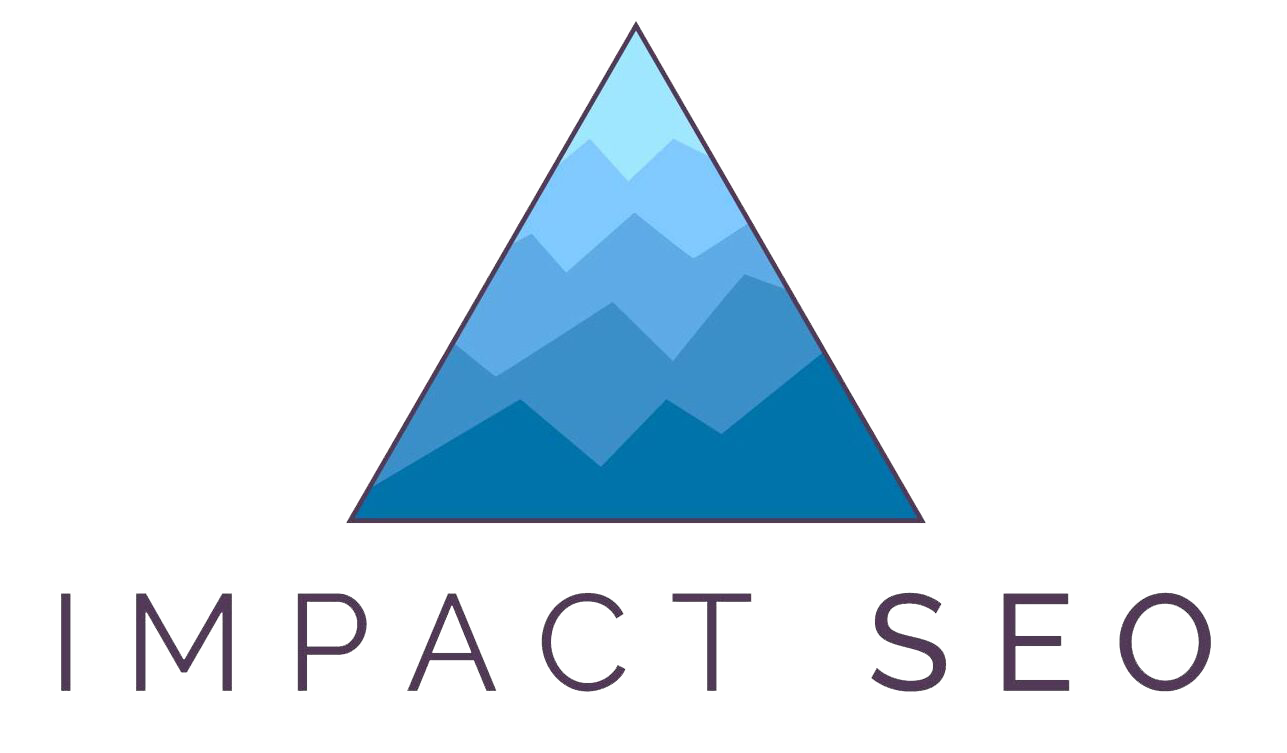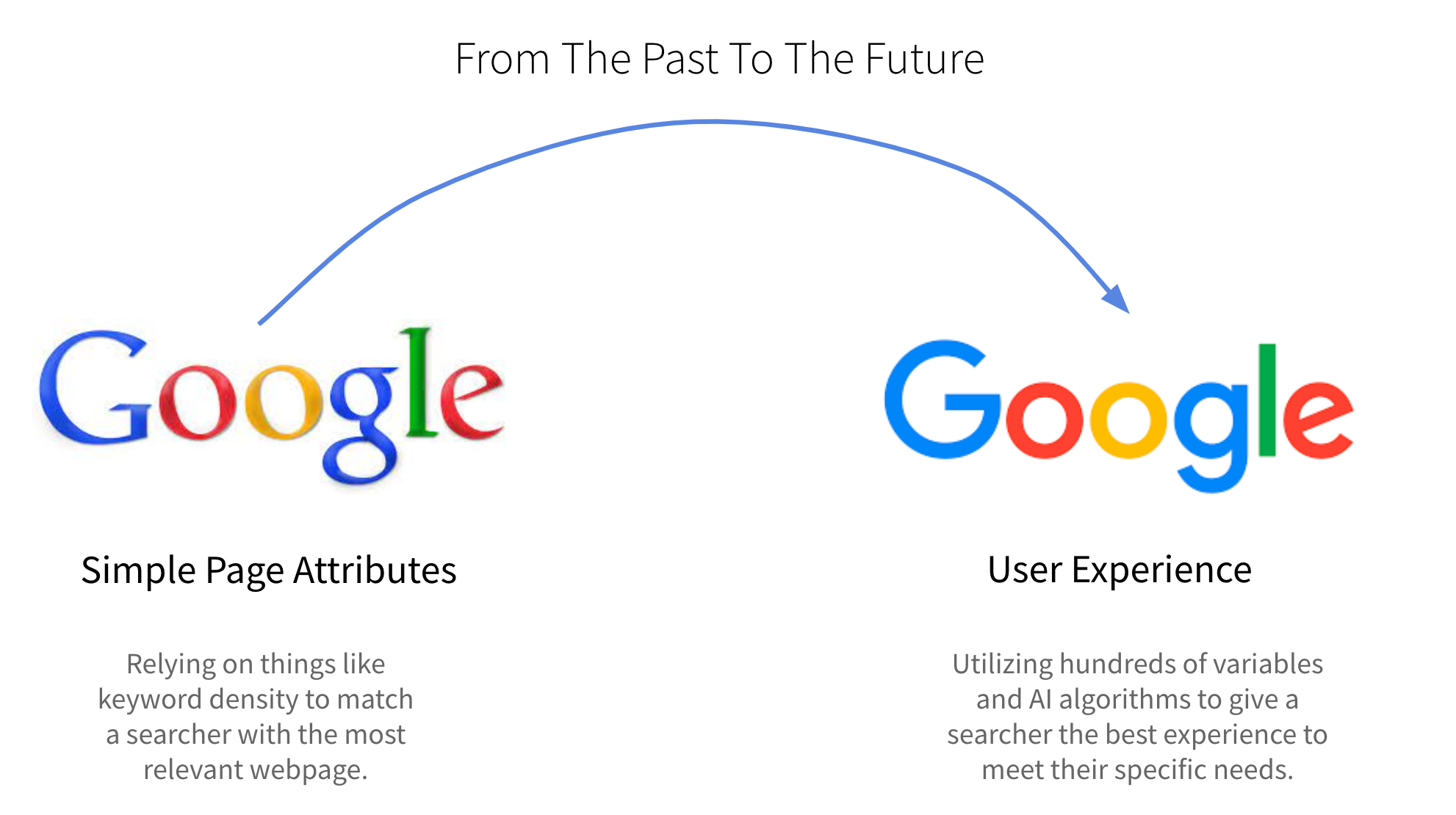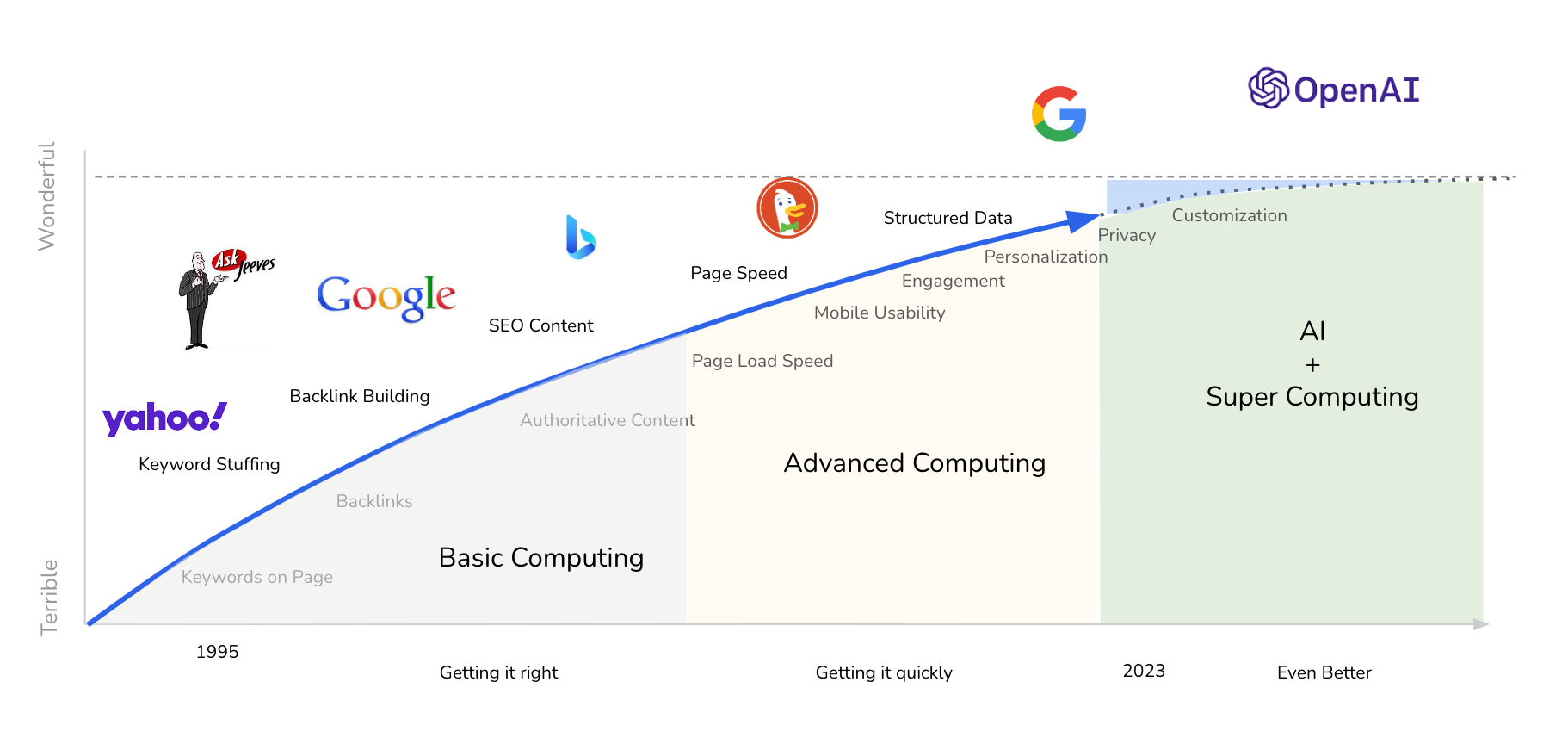If you’re responsible for raising awareness and generating donations, the future of your organization is in your hands.
COVID accelerated big changes that are disrupting how we market and destabilizing our organizations… but, they also pose a tremendous growth opportunity for those who can adapt.
If your marketing and communications haven’t fully adapted, your organization is at risk.
COVID accelerated the inevitable: our transition to digital-first communications.
| Goal | Before | After |
|---|---|---|
| Getting Things Done | Meetings in person | Zoom |
| Raising Funds | Galas, Balls, Other Events | Online events, individual donors |
| Raising Awareness | Community events, Social Media marketing | Podcasts, video, TikTok? |
| Networking | Meetups, Events, Seminars | Digital Summits, LinkedIn, Zoom |
This graph helps us visualize the decline of “Traditional” nonprofit marketing and the rise of “Modern” nonprofit marketing.
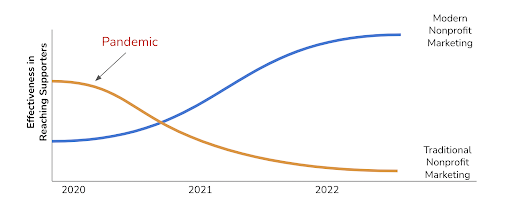
Do you know where on this graph your organization is?
Part 1: (Really) Understanding Our Situation
Clarify What You Can and Can Not Influence
We are not able to control general trends influenced by pandemics.
We CAN control how we respond and adapt to them.
It’s our responsibility to determine:
- Where we are right now (and communicate that to our board)
- What we can control and what we can’t control
How we will respond in a way that gives our organization the best opportunity to thrive
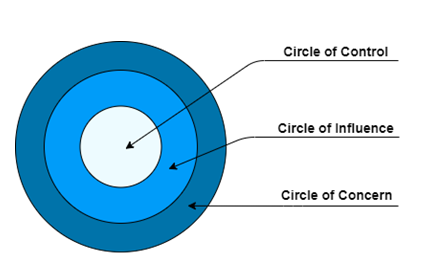
Before jumping into action, let’s take a step back and make sure we accurately evaluate where we are now and where we are headed.
Evaluate the Situation: What’s My Organization’s Trajectory?
How do we evaluate our situation objectively? We use reliable data sources that help us evaluate performance and predict growth or decline.
Not all performance metrics are meaningful or useful.
If you’re looking at the wrong data you’ll have an inaccurate visualization of reality.
We need to use metrics that reliably indicate which communications channels are most effective at:
- Raising awareness for our cause
- Building trust with potential supporters
- Bringing in donations
Reliable data IS NOT:
- Facebook likes
- Instagram followers
- # of posts published
These are largely vanity metrics that might provide a sense of directional accomplishment but will not keep your organization funded and aren’t likely to impress your board of directors.
Reliable data IS:
- Dollars Raised – broken down by marketing channel and campaign
- Supporters Garnered – people who took a significant action to show they care about what you do, i.e. giving you their email so you can update them about the progress of your cause.
- New People Engaged – in a meaningful way, like visiting your website AND engaging with your educational materials.
If you aren’t confident about the data you’re using to evaluate your marketing and communications performance, here’s a refresher:
How To: Set Goals, Setup Data Sources, and Evaluate Performance (for Nonprofit Marketing)
After we clarify our organization’s trajectory, how do we make good decisions that will steer us away from struggling and toward thriving?
Part 2: 5 Ways To Influence Your Organization’s Growth Trajectory
A small strategy shift today can be the difference between a thriving organization or a struggling cause.

2020 delivered us a big, unexpected blow.
Now it’s our job to embrace change and start working on the things within our circle of influence so we can correct course to steer our organization in the right direction.
Here are 5 steps you can take to change the trajectory of your organization.
The Big 5 Growth Trajectory Changers
- Stretch The Budget
- Mitigate Your Risks on SM
- Adapt To Changing Attention Spans
- Segment To Improve Retention
- Prioritize The Growth Market
Step 1: Stretch the budget
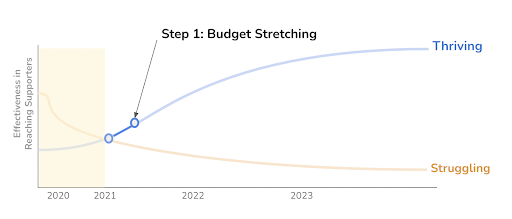
If you’re like most nonprofits, donations have decreased since Spring of 2020. This means you’re tasked with trying to help your organization recover even though you have less resources to do so.
To prevent ourselves from entering a doom loop, we need to change our approach.
Beyond just evaluating growth goals and resources, then allocating budgets… we need to look for two key investment opportunities:
- Foundational Assets – the building blocks that make all our other marketing efforts easier and more effective.
- Compounding Investments – marketing activities that get stronger with time while requiring less energy input.
These two marketing strategies fall under the Core Spend category.
When we allocate budget to cover Core Spend and carefully watch our Fringe Spend, we can stretch the budget responsibly and change the trajectory of our organization.
Understanding Core and Fringe Spending
In nonprofit marketing there are Core spend areas and Fringe spend areas. If you manage them poorly, you put your organization at risk of entering a doom loop.
If you manage them properly you will change the trajectory of your organization.
Core Spend Areas
Core Spend areas are like keystone species. They have an unproportional impact on the health of your organization. Without them it’s difficult or impossible for your organization to sustain.
Core Spend areas:
- Foundational Assets – Build a foundation that makes other communication channels stronger
- Compound Interest – Tactics and marketing channels that get stronger and more effective with time.
- Aligned Efforts – Marketing actions that are directly aligned with the lifeblood of your organization: donations and support from your community.
Fringe Spend Areas
Fringe Spend areas play a role in the health of your organization, but have a much lower impact than Core Spend areas. Unlike Core Spend efforts, your organization can still sustain without Fringe Spend.
Fringe Spend areas:
- Might represent a significant portion of your donations from time to time but are inconsistent or unsustainable
- Require additional support channels to be effective
- Slow down or disappear without constant management
For most nonprofits, your website is the simplest example of a Core spend area. If it is healthy, it supports all other communications efforts because you have a strong reference point for people to come back to.
Whether someone sees you on Facebook, from a mention in their local news, or even word of mouth, guess where they will go to learn more? (Your website)
As you have already guessed, Facebook is commonly mistaken as a Core Spend activity when it more often a Fringe Spend activity. Investing too heavily in Fringe Spend activities is unsustainable and puts your organization at risk.
Note: Social Media is great when used properly. In Step 2, we’ll cover how to minimize your risk while maximizing your upside potential on platforms like Facebook.
Examples of Common Core and Fringe Spend Channels
| Core | Fringe |
|---|---|
| Website Performance Website Content (Updates & Expansion) Donor Relations Email Marketing (Updates & Asks) Annual Events / Reports | Social Media (above and beyond basic supporter engagement) Podcasts (and other experimental campaigns) Webinars Google Ad Grant Retargeting |
Takeaway Questions:
- Do you know what your Core vs Fringe Spend Areas are? (And why?)
- Is your budget allocation in line with your Core and Fringe Spend Areas?
Step 2: Mitigating Risk of Overspend on Social Media
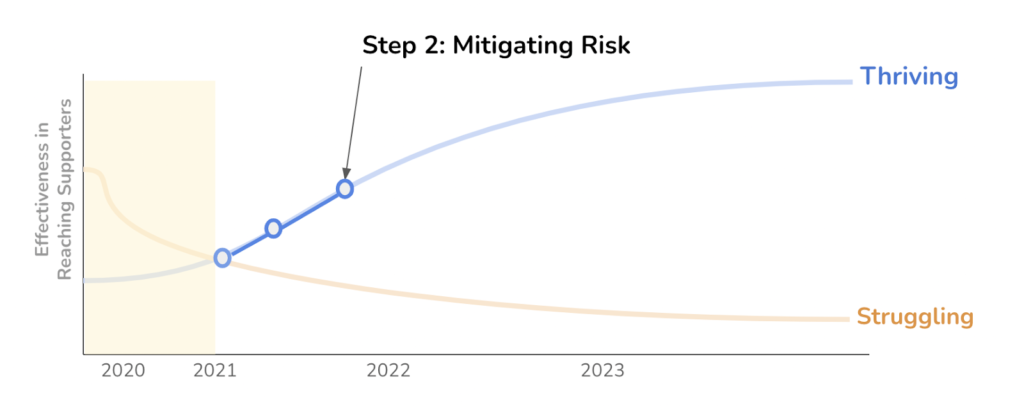
Social Media platforms like Facebook may have been fruitful for your communications and fundraising thus far, BUT that does not mean they always will be OR that they are the best use of your time and money.
There are several risks that come with the territory.
If you want to decrease your risk of major setbacks while maximizing your ROI:
- Be fully aware of the upside and downsides of each platform.
- Play the long game. Make decisions that benefit the longevity of your organization, not quick wins backed by vanity metrics.
Platforms like Facebook, Instagram, and other Social Media channels, are Fringe Spend activities because they generally:
- Are not likely to be a sustainable source of donations in the long run (5+ years from now).
- Lose momentum as soon as you stop spending time and money on them.
- Don’t function effectively on their own.
- Carry a high risk because they can change overnight without warning.
The Risk of Gradual Decline
These platforms are driven by the attention economy, which is only speeding up. That means your latest post is lost in the news feed even faster. Which means you need to produce more content, that takes more time and money, with ever-decreasing returns.
Posting platforms like Hootsuite only help you hack the system to keep up with the ever-growing flood of content and people vying for the limited attention of platform users.
Is this the best use of resources for your organization?
The Risk of Instantly Disappearing
Here are existential risks that come from depending too much on platforms that have complete control:
- Accounts / pages can be banned with no explanation and no chance of recovery
- Algorithms can change overnight, suddenly dropping your visibility
- Example: Facebook is currently under scrutiny. People are leaving the platform, they’ve been tagged as a monopoly, and are pending government regulation.
Your Mitigation Strategy
Social Media can be very effective and play an important role in your overall strategy. These Do’s and Don’ts can help you mitigate big risks and maximize your long term growth potential:
5 Don’ts
- Don’t rely on one big burst from social platforms to reach your growth goals
- Don’t risk big setbacks by putting your organization’s future in the hands of platform CEOs like Mark Zuckerberg
- Don’t borrow from your future for today by overinvesting in social and underinvesting in your own assets like your website and supporter lists
- Don’t run ads unless you can accurately measure real performance metrics and you are getting positive ROI
- Don’t follow the crowds – “we have to do it this way, because this is how everyone else does it”
3 Do’s
- Objectively evaluate each channel’s performance to your key goals (using real KPIs)
- Evaluate ROI on time and money spent. Always consider the big picture by evaluating effectiveness over the longterm – 3 years or more.
- Seek to understand the relationship between channels. You may find that investing in conversion rate optimization on your site has a bigger impact than posting 50 updates on Instagram over the next 30 days (more on this next…)
If you’re over-allocating on Fringe Spend activities like social media, it may be time to course correct.
Step 3: Adapt to Dwindling Attention Spans
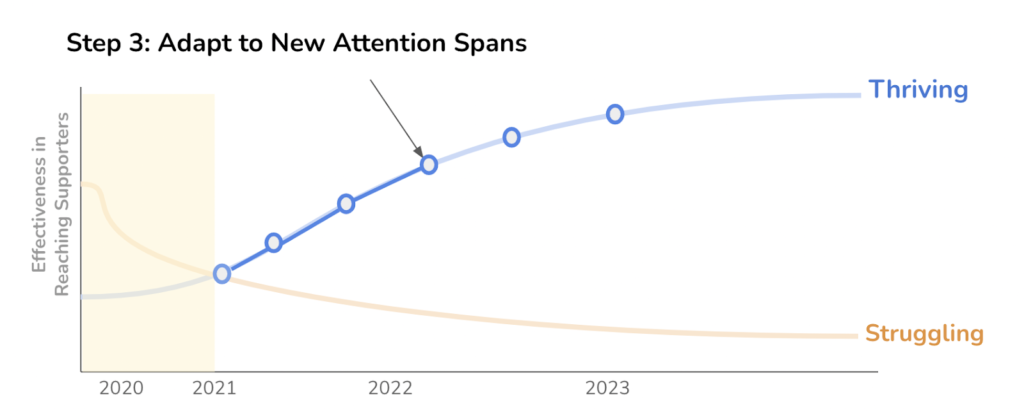
Screen fatigue is real.
Your supporters have a limited amount of time and you’re competing with an ever-growing and shocking world of headlines and emotional news stories.
The information you provide has to be super clear, simple, and easy to navigate.
How do you provide a better experience for lower attention spans?
- Improve Navigation – find out what your primary target audience is looking for and make it very easy for them to find.
- Write Very Clearly – edit, edit, and edit some more. Your website visitors will give up if you make them work too hard to extract the information they are seeking.
- Get To The Point – you don’t build any extra trust with someone by using more words than necessary to make a point.
- Organize Your Information – make information you provide to potential and existing supporters extremely easy to scan and mobile friendly.
- Use Relevant CTAs – different pages on your website serve different purposes for your audience. Make sure you have the right next step available for your potential supporters wherever they are in their journey.
How do seemingly small adjustments in communication compound over time?
Imagine what a 5-10% increase in engagement would do for your organization…
- Across 6 different channels
- Over a period of 3 years
How do we get this done?
DO NOT: Make big sweeping changes based on your gut.
DO: Use a thoughtful methodology that uses data to make incremental improvements over time.
- Set clear goals. Know WHO you want to reach and HOW to measure engagement effectively.
- Use reliable data that comes standard in Google Analytics to help you make decisions – engagement metrics such as behavior flow, bounce rate, etc. (make sure you work with a big enough sample size to get credible insights)
- Run limited, small experiments to test improvements
- Iterate to get stronger and stronger
Providing a better experience for your target audience is a foundational marketing activity that will make all of your efforts more effective.
Step 4: Segment Even More
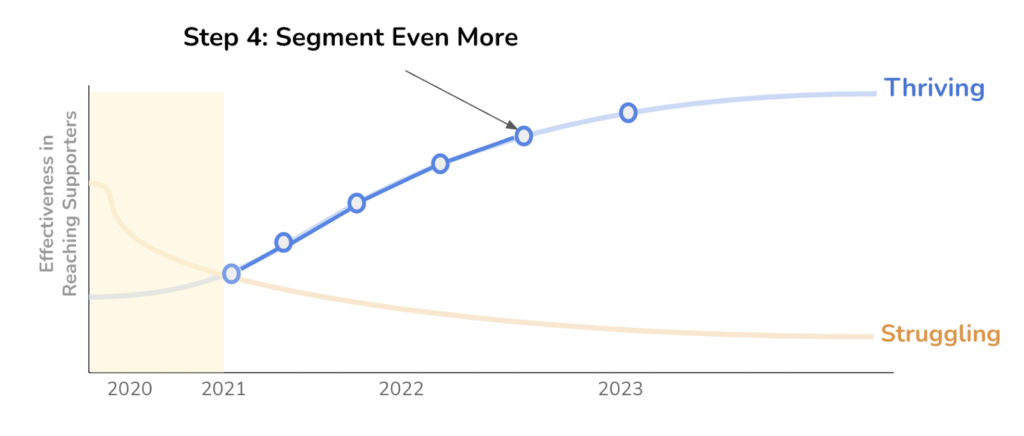
Digital overwhelm is real.
Don’t shoot yourself in the foot by being too aggressive or too sloppy with your supporter communication.
You’ve likely experienced the “negative brand affect” when signing up for an email list.
- You subscribe to a mailing list for something you’re interested in
- Over the next 2-3 days your inbox is flooded with way more information and offers than you can digest
- You get overwhelmed, unsubscribe, and move on with your life
When you take the time to provide a thoughtful line of communication with your supporters and you execute it effectively, you’ll see less drop-off and more supporters turning into advocates.
Key Components of Thoughtful Communication with Supporters
Have Patience
- Take the time to properly onboard a new supporter.
- Facilitate their education around your cause. Don’t overload them with information.
- It’s better to leave them wanting for more, than to overwhelm them and have them write you off.
Cultivate Focus
We all have too much email already. Keep it light and to the point.
Identify the core topics and sub-topics your supporter is interested in early on. Then, cater to their interests by only communicating on those issues. Trust that they will seek to expand their flow of information to additional topics if they are interested.
Don’t assume that because they subscribed to your mailing list they want to get updates on everything your organization does.
Ask for Permission
Show respect for your supporter’s time by asking for their permission.
Don’t be afraid to ask them what they want.
- What topics are you interested in learning about or getting updates on?
- How often would you like to receive updates about our work?
- Would you like to know about fundraising events?
A simple one-minute survey can help you segment your email subscribers so you can provide a tailored experience that makes them feel heard, builds trust, and increases your supporter-to-advocate conversion rates.
Takeaways
- Respect the time of your supporters
- Segment your email subscribers to provide a better exchange of information
- Take your time to onboard new supporters so they grow into advocates, rather than ignore you
Step 5: Reach Millennials and Gen Z The Right Way
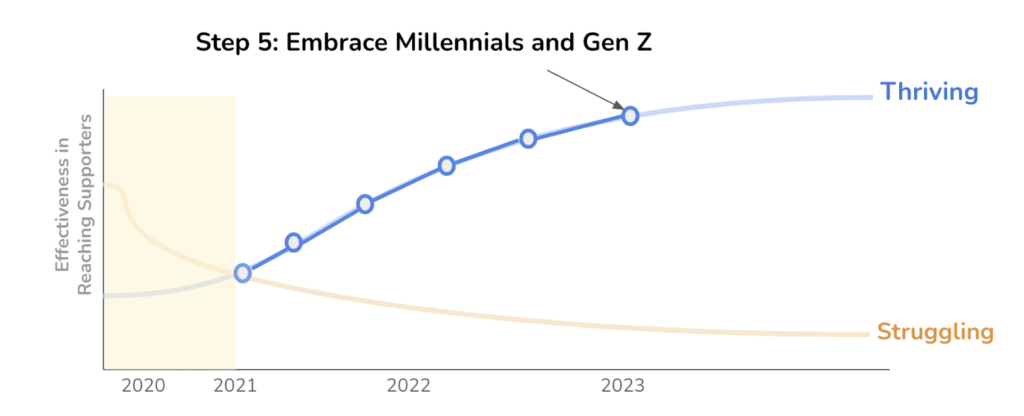
If you’re not already catering to the needs of the next generation, it’s time to catch up.
BUT… catching up doesn’t mean aggressively investing in a new channel you know nothing about.
Millennials and Gen Z are a growing portion of our support base.
- They care more about the environment than older generations
- They are tech savvy
- Their economic influence is growing daily as they enter the workforce
How do you optimize for the next generation?
Focus on Flywheels…
The Flywheel vs The Doom Loop: Connecting with GenZ and Millennials
Jim Collins’, author of Good to Great: Why Some Companies Make the Leap… and Others Don’t, brilliantly uncovered the difference between organizations that thrive and those that struggle.
Organizations that flourish do so by consistently making good decisions and executing with discipline. They make a series of good decisions, supremely well-executed, that add up one upon another over a long period of time to create a great result.
Over time this consistency creates a flywheel that gains momentum. (Slowly changing the trajectory resulting in a tremendous impact over time)
From the outside, it looks like an enormous breakthrough. On the inside, it’s the result of consistency and discipline over time.
Organizations that struggle buy into the idea of dramatic moments or radical transformations. They try to jump to break through in one big step, rather than building a flywheel.
The Doom Loop
The “doom loop” for marketing to younger generations looks something like this:
- Rush to new platforms as soon as you hear about it
- Mimic “successful” accounts
- Hope that it works…
- Try again when the next trend arises
Don’t bet the future of your organization on the next hot trend. Be authentic to the next generation and do your homework.
The Flywheel
The flywheel for marketing to the next generation looks something like this:
- Seek to understand the needs of your emerging new support base
- Make sure you communicate your cause clearly to your supporters via your website
- Experiment with limited campaigns across multiple channels with an aim to bring people back to your website
- Evaluate your results with reliable performance metrics
- Repeat – use this new information to better understand your support base and iterate, continuing to turn the flywheel
Build yourself a positive feedback loop that gets stronger with time, not a point-and-shoot doom loop.
If you want to leverage the support of future generations, seek first to understand them, then to serve them. Rather than betting the farm on Tik Tok, stick to your foundational marketing efforts and run limited experiments to test the waters on new platforms.
Takeaway Questions:
Are you using reliable data and disciplined decisions to build a flywheel for your organization?
Or,
Are you looking for big breakthroughs that have a low probability of materializing?
Adapting To Thriving in The New Normal
The new age of digital is not coming. It is already here.
If we try to ignore these changes and hope they go away… we jeopardize the future of the organizations we have fought so hard to build.
But, this change offers tremendous opportunity for those who pay attention and cultivate the discipline to make informed decisions.
Here we’ve provided 5 steps to help slingshot you into 2021. What challenges are you facing that we haven’t addressed?
Let us know what you’re facing by submitting a comment.
Or, ask a question privately for feedback:
